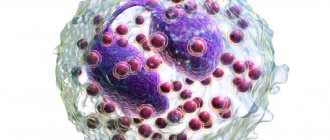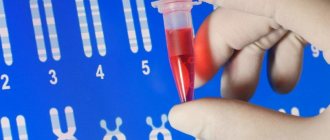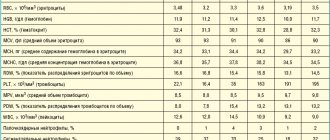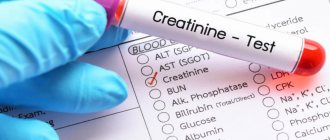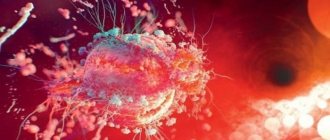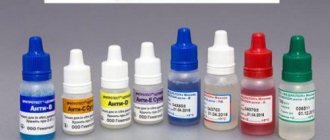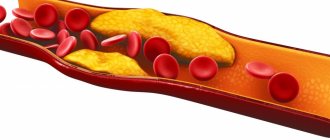General information
Antithrombin III (glycoprotein, plasma protein) is the main anticoagulant of the blood system, which blocks coagulation factors and promotes its natural thinning. Its main function is to regulate the formation of blood clots during bleeding, that is, to deactivate excessive thrombus formation.
Analysis for antithrombin III as part of a coagulogram allows you to evaluate its quantity (antigen test) and quality (activity).
As a result of injury, impact, compression or surgery, the integrity of the tissue and, as a result, the vessels located in it are damaged. The body's response to damage is the release of coagulative components, which contribute to the formation of a blood clot that stops bleeding in the vessel. Antithrombin III regulates the process of thrombus formation, since an excessive number of such clots leads to complete blockage of the lumen of the vessel, which prevents blood from entering a certain area.
The glycoprotein antithrombin III is produced by the inner layer of blood vessels - the endothelium - and liver cells with the participation of vitamin K. After synthesis, it is released into the bloodstream, where it inhibits the coagulation factor thrombin, as well as IXA, XA, XIA, XIIA factors. The natural process proceeds quite slowly, but in the presence of heparin it accelerates sharply. If the level of antithrombin decreases critically, then heparin loses its biological activity - there is a risk of vascular blockage (thrombosis).
Plasma protein deficiency can be acquired and hereditary (1:5000 cases). If the patient is at risk, thrombosis can develop after 20 years.
Experts define 2 types of deficiency. In the first case, antithrombin is biologically active, but is produced in insufficient quantities. The second type is characterized by normal secretion of defective antithrombin, which is not capable of performing an anticoagulation function.
Regardless of the reasons for the decrease in the concentration of this protein, the main manifestation of deficiency is thrombosis of the veins and arteries, which periodically recur. In pregnant women, insufficient production of antithrombin increases the likelihood of spontaneous abortion.
Congenital deficiency manifests itself as strokes or myocardial infarctions in young patients, thrombosis in infants (rarely). The condition is also aggravated by pregnancy and childbirth, surgical interventions, infectious and inflammatory processes, and the use of oral contraceptives.
Normally, antithrombin decreases with age in men, and in women after menopause.
Antithrombin III human
Treatment should be initiated under the supervision of a physician experienced in treating patients with antithrombin deficiency.
Doses
For congenital deficiency, the dose should be adjusted individually for each patient, taking into account family history of thromboembolic conditions, existing clinical risk factors, laboratory results and plasma antithrombin III levels.
In cases of acquired deficiency, the dose and duration of replacement therapy depend on the activity of antithrombin in plasma, the presence of signs of increased metabolism of antithrombin, as well as the underlying disease and the severity of the clinical condition.
The dose and frequency of administration should always be based on clinical effectiveness and laboratory results in each individual case.
The number of units of antithrombin administered is expressed in international units (IU), which are calculated in relation to the current WHO standard for antithrombin. Antithrombin activity in plasma is expressed either as a percentage (relative to normal human plasma) or in international units (relative to the international standard for antithrombin in plasma).
1 international unit (IU) of antithrombin activity is equivalent to the antithrombin activity in one milliliter of normal human plasma. Calculation of the required dose of antithrombin is based on empirical data that 1 international unit (IU) of antithrombin per kilogram of body weight increases plasma antithrombin activity by approximately 2%.
The initial dose is calculated using the following formula:
Required dose
( ME ) = body weight (kg) x (target level - initial level of activity [%]) x 0.5
The initial target activity of antithrombin depends on the clinical situation. If replacement therapy is indicated, the dose should be sufficient to achieve the target antithrombin activity, as well as to maintain its effective concentration. The dose should be determined and monitored based on laboratory measurements of antithrombin activity, which should be determined at least twice daily, preferably immediately before the next administration. Dose adjustment is carried out taking into account laboratory manifestations of increased antithrombin metabolism and the clinical course of the disease. Antithrombin activity should be maintained above 80% throughout the course of treatment, unless clinical features indicate the need to maintain a different effective level.
Typically, the initial dose for congenital deficiency is 30-50 IU/kg. Subsequently, the dose, interval between administrations and duration of treatment must be adjusted taking into account the results of biochemical studies and the clinical situation.
The use of antithrombin III in children under 6 years of age has not been sufficiently studied.
Mode of application
The drug is administered intravenously. The maximum injection rate is 5 ml/min. Dissolve the contents of the bottle with the drug Antithrombin III human immediately before administration. For this purpose, only the supplied dissolution and administration kit should be used. The resulting solution must be used immediately after dissolution, since the drug does not contain preservatives.
Before administration, the solution must be visually examined for the presence of foreign inclusions or color changes. Solutions that are cloudy or contain sediment should not be used. Unused solution must be disposed of in accordance with established rules.
Preparation of the solution
— Warm the closed bottle with the solvent to room temperature (not higher than 37 ° C).
— Remove the protective caps from the lyophilisate and solvent bottles (Fig. A) and disinfect the rubber stoppers on both bottles.
— Turn and then remove the protective cap from one end of the supplied adapter needle (Fig. B). Pierce the stopper of the solvent bottle with the free end of the needle (Fig. B).
— Remove the protective cap from the other end of the adapter needle without touching the needle itself.
— Turn the bottle with the solvent over and pierce the stopper of the bottle with the lyophilisate with the free end of the needle (Fig. D). The solvent will flow into the vial with the lyophilisate under the influence of vacuum.
— Separate the bottles by removing the needle from the drug bottle (Fig. E). Gently shaking or rotating the bottle will speed up the dissolution of the powder.
— After complete dissolution of the drug to deposit foam, pierce the stopper of the bottle with the drug (Fig. E). Then remove the airway needle.
Introduction of the resulting solution
— Turn and then remove the protective cap from the included filter needle and place the needle on a sterile disposable syringe. Draw the solution into the syringe (Fig. G).
— Disconnect the filter needle from the syringe and slowly (maximum injection rate 5 ml/min) inject the solution intravenously using the included disposable needle (butterfly needle).
Indications
Antithrombin III testing is most often carried out as part of a coagulogram in the following cases:
- Screening of patients at risk (there were cases of antithrombin deficiency in the family history, thrombosis of veins or arteries was observed before the age of 50);
- Estimation of the amount of functionally useful antithrombin III;
- Thromboembolic pathologies: thrombosis of deep veins or mesenteric vessels;
- myocardial infarction;
- pulmonary embolism;
- stroke;
- thrombophlebitis;
- miscarriage (history);
Complexes with this research
Coagulogram Study of the functional state of hemostasis 2,080 ₽ Composition
Examination during pregnancy. 3rd trimester 9,840 ₽ Composition
Miscarriage Identification of the main causes of miscarriage RUB 40,440 Composition
IN OTHER COMPLEXES
- Female infertility RUB 16,470
- Examination during pregnancy. 1st trimester 17,040 RUR
- Pregnancy planning. Clinical indicators 6,800 ₽
- Extended coagulogram RUB 4,230
- Joining IVF RUB 23,500
AT III normal
Standard reference ranges
The antithrombin activity of whole donor plasma is taken as 100%.
| Age | Norms |
| Less than 3 days | 58 — 90 % |
| 3 days – 1 month | 60 — 89 % |
| 1 month – year | 72 — 134 % |
| 1-6 years | 101 — 131 % |
| 6-11 years | 95 — 134 % |
| 11-16 years old | 96 — 126 % |
| More than 16 years | 66 — 124 % |
Norms during pregnancy:
| Gestational age in weeks | Antithrombin III, % |
| 13 – 21 | 74 – 115 |
| 21 – 29 | 73 – 114 |
| 29 – 35 | 76 – 112 |
| 35 – 42 | 70 – 116 |
AT III standards in the independent laboratory Invitro
- For women of childbearing age and men – from 83 to 128%.
What is antithrombin III (AT-III)?
Antithrombin III (AT III, Antithrombin III) is a protein produced in the liver, its main function is the regulation of blood clotting.
Antithrombin III maintains a fluid state of the blood, moderately inhibiting the action of some other coagulation factor proteins. Thus, AT III prevents the formation of thrombi - blood clots that can completely block blood flow in a vessel. Antithrombin deficiency is usually divided into two types:
- antithrombin is produced in smaller quantities than required;
- antithrombin is produced in normal quantities, but its dysfunction is observed.
What can distort the result
The following factors influence the results of the study:
- treatment with heparin and estrogens - they reduce the level of antithrombin in the blood;
- in the case of infectious, viral and inflammatory diseases (including influenza, ARVI, sore throat, rhinitis, etc.), the activity of antithrombin decreases, which also reduces its indicator.
Important! The interpretation of the results is always carried out comprehensively. It is impossible to make an accurate diagnosis based on only one analysis.
Interpretation of results:
Inherited AT deficiency (less common) is often associated with thromboembolic disease, and acquired AT deficiency (more common) can occur with liver disease, kidney disease, metastatic cancer, and disseminated intravascular coagulation (DIC).
Related Products:
Hemostat Antithrombin liquid
The chromogenic test based on factor Xa allows the quantitative determination of functionally active antibodies even at low levels. Its advantage is that it:
• ready to use
• with reagent stability of 21-25 hours
• insensitive to heparin
References 1. Bhakuni, T., et al., Antithrombin III deficiency in Indian patients with deep vein thrombosis: identification of first India based AT variants including a novel point mutation (T280A) that leads to aggregation. PLoS One, 2015. 10(3): p. e0121889. 2. Khor, B. and E. M. Van Cott, Laboratory tests for antithrombin deficiency. Am J Hematol, 2010. 85(12): p. 947-50. 3. Bauer, K. A., T. M. Nguyen-Cao, and J. B. Spears, Issues in the Diagnosis and Management of Hereditary Antithrombin Deficiency. Ann Pharmacother, 2021. 50(9): p. 758-67. 4. Patnaik, M. M. and S. Moll, Inherited antithrombin deficiency: a review. Haemophilia, 2008. 14(6): p. 1229-39. 5. Funk, DM, Coagulation assays and anticoagulant monitoring. Hematology Am Soc Hematol Educ Program, 2012. 2012: p. 4605. 6. Thachil, J. and C. H. Toh, Current concepts in the management of disseminated intravascular coagulation. Thromb Res, 2012. 129 Suppl 1: p. S54-9.
Exceeding the norm
- Acute infectious or inflammatory process;
- Diseases of the liver (viral hepatitis, cholestasis) and kidneys, transplantation of these organs;
- Pathologies of the pancreas (acute pancreatitis, oncology);
- Lack of vitamin K in the body;
- Menstrual bleeding (temporary increase, which should be considered normal);
- Therapy with indirect anticoagulants (for example, phenylin, warfarin), anabolic steroids.
Note:
an increase in antithrombin concentration indicates a risk of internal bleeding.
